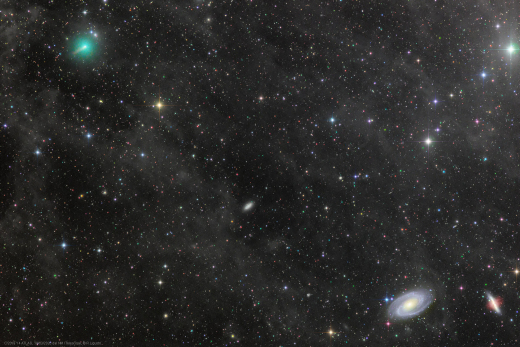Tweet showing the progress of the brightening of Comet C/2019 Y4:
You are using an out of date browser. It may not display this or other websites correctly.
You should upgrade or use an alternative browser.
You should upgrade or use an alternative browser.
Near-Earth objects and close calls
- Thread starter Gawan
- Start date
Another update on Comet ATLAS Y4 from yesterday 18th March, from SpaceWeather.com.
Primarily of note is that the comet continues to brighten "a 4000-fold increase" since February; they don't know the size of its nucleus, "If it has a big nucleus [...]"; and that it may become visible to the naked eye by early April. Also, whatever happens, NASA's camera's should be able to capture all this activity.
There's a few more predictions such as that it may break up as it approaches the Sun, and that because it is brightening so fast it may also break up or dim equally fast. But SW is working on the erroneous 'dirty snow ball' theory so it's possible they may be surprised by what happens next.
Some recent tweets with additional visuals:
Primarily of note is that the comet continues to brighten "a 4000-fold increase" since February; they don't know the size of its nucleus, "If it has a big nucleus [...]"; and that it may become visible to the naked eye by early April. Also, whatever happens, NASA's camera's should be able to capture all this activity.
There's a few more predictions such as that it may break up as it approaches the Sun, and that because it is brightening so fast it may also break up or dim equally fast. But SW is working on the erroneous 'dirty snow ball' theory so it's possible they may be surprised by what happens next.
Spaceweather.com Time Machine
spaceweather.com
COMET ATLAS IS BRIGHTENING FASTER THAN EXPECTED: Get ready for a wild ride. Comet ATLAS (C2019 Y4) is plunging toward the sun and, if it doesn't fly apart first, it could become one of the brightest comets in years.
"Comet ATLAS continues to brighten much faster than expected," says Karl Battams of the Naval Research Lab in Washington DC.
"Some predictions for its peak brightness now border on the absurd."
Above: Comet Atlas (upper left) glides by spiral galaxy M81 on March 18th. Credit: Rolando Ligustri [more]
The comet was discovered in December 2019 by the Asteroid Terrestrial-impact Last Alert System (ATLAS) in Hawaii. Astronomers quickly realized it might be special. On May 31, 2020, Comet ATLAS will pass deep inside the orbit of Mercury only 0.25 AU from the sun. If it can survive the blast furnace of solar heating, it could put on a good show.
However, no one expected the show to start this soon. More than 2 months before perihelion (closest approach to the sun), Comet ATLAS is already "heating up." [or rather it's becoming electrically active]
The worldwide Comet Observation Database shows it jumping from magnitude +17 in early February to +8 in mid-March–a 4000-fold increase in brightness. It could become visible to the naked eye in early April.
"Right now the comet is releasing huge amounts of its frozen volatiles (gases)," says Battams. "That’s why it’s brightening so fast."
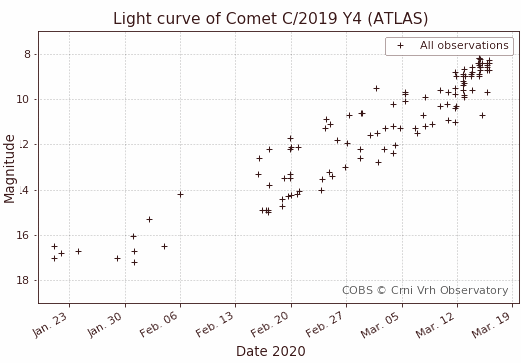
Can ATLAS sustain this crazy pace? If it has a big nucleus w ith large stores of frozen gas, then yes; we could get a very bright comet. Otherwise, Comet ATLAS might run out of gas, crumbling and fading as it approaches the sun.
Current best estimates of the comet’s peak brightness in May range from magnitude +1 to -5. If Comet ATLAS hits the high end of that range, a bit brighter than Venus, it could become visible in broad daylight.
Comet McNaught (C/2006 P1) performed that very trick 13 years ago. On Jan. 13, 2007, it swooped past the sun shining at magnitude -5. The absurdly-bright comet was visible at high noon with its tail jutting across blue sky:
Battams is not optimistic, though: "My personal intuition is that Comet ATLAS is over-achieving, and I wouldn’t be surprised to see it fade rapidly and possibly even disintegrate before reaching the sun," he says.
Come to think of it, that would be a good show, too. Fortunately, NASA has spacecraft with cameras that specialize in seeing things close to the sun.
"The Heliospheric Imager on NASA's STEREO spacecraft will get a great view of ATLAS from mid-May through early June," says Battams. "The camera is very sensitive, so we might be able to observe ATLAS’s tail interacting with the solar wind and outflows–as well as any potential breakup events."
Some recent tweets with additional visuals:
Tyomodachi
Jedi
Я думаю, что это еще одна часть плана скрыть от общественности информацию о космических угрозах, сохранить контроль и в то же время списать на спутники странные небесные явления.
Астроном Гарварда говорит, что Starlink может повлиять на охоту на околоземных астероидов
SpaceX и другие компании стремятся добавить тысячи спутников к небу, и астрономы обеспокоены.
Известный астроном и спутниковый трекер говорит, что обсерватории, которые сканируют небо на наличие потенциально опасных астероидов, могут быть затронуты планом SpaceX по развертыванию более 12 000 спутников на низкой околоземной орбите в течение следующих нескольких лет.
Джонатан Макдауэлл из Гарвард-Смитсоновского центра астрофизики поделился проектом своего нового исследования, в котором рассматриваются эффекты, которые мега-созвездие широкополосного сервиса Starlink может оказать на различные обсерватории.
«Астрономы - и случайные зрители ночного неба - должны ожидать будущего, в котором население низкой околоземной орбиты включает в себя десятки тысяч относительно больших спутников», - пишет Макдауэлл в статье, которая была принята для публикации в Astrophysical Journal Letters .
[/ QUOTE]
Ряд астрономов и астрономических организаций выразили свою обеспокоенность тем, что рост огромных спутниковых созвездий, во главе с планом Starlink по развертыванию до 42 000 спутников в долгосрочной перспективе, будет мешать научным наблюдениям космоса.
Почти сразу после того, как SpaceX начал запуск спутников в 2019 году, обычные наблюдатели за небом и профессиональные астрономы были поражены яркими лучами света в сумеречном небе и в поле зрения крупных телескопов.
И яркость, и огромное количество спутников - не только от SpaceX, но и от таких конкурентов, как OneWeb, - создают проблему для астрономов. Многие указали на обсерватории с особенно широкими полями зрения, такие как предстоящая обсерватория Веры К. Рубин в Чили, которые, вероятно, будут наиболее подвержены воздействию.
[/ QUOTE]
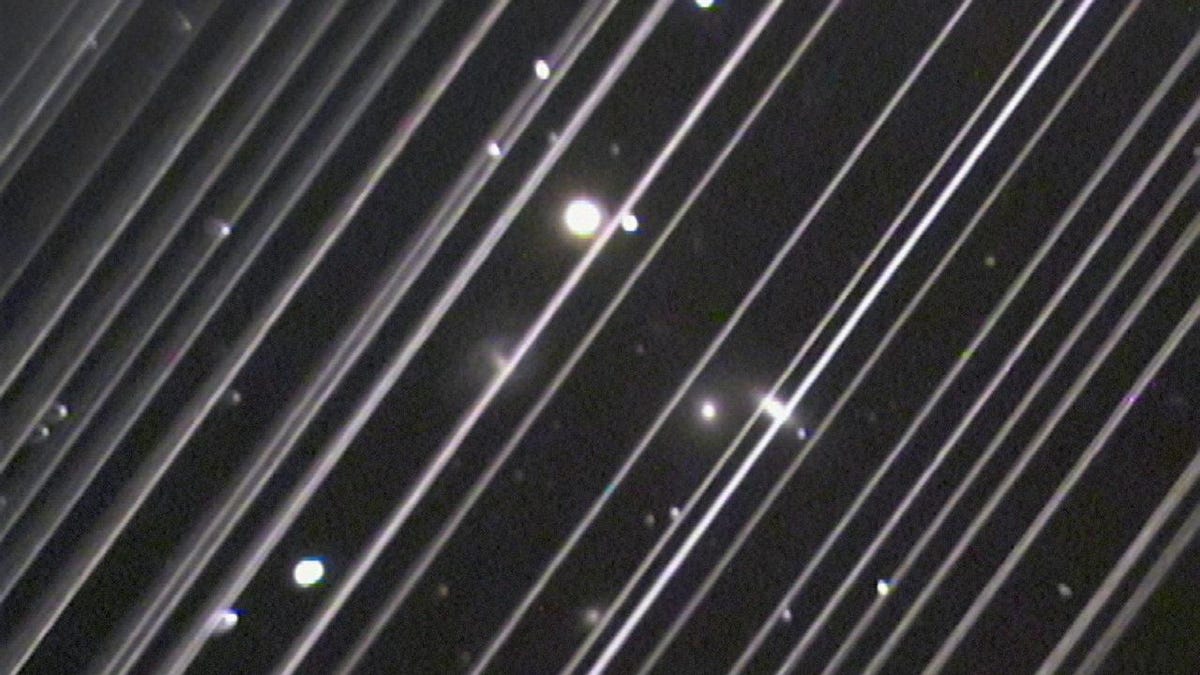
Harvard Astronomer Says SpaceX's Starlink Could Affect Hunt For Near-Earth Asteroids
SpaceX and other companies are looking to add thousands of satellites to the sky and astronomers are concerned.www.cnet.com
Tyomodachi
Jedi
I think this is another part of the plan to hide information about space threats from the public, maintain control and at the same time write off strange celestial phenomena to satellites.

 www.cnet.com
www.cnet.com
sorry for last post forgot to turn off the translation
Harvard astronomer says Starlink could affect hunt for near-earth asteroids
SpaceX and other companies are looking to add thousands of satellites to the sky and astronomers are concerned.
A well-known astronomer and satellite tracker says observatories that scan the sky for potentially hazardous asteroids could be impacted by SpaceX's plan to deploy over 12,000 satellites to low Earth orbit over the next several years.
Jonathan McDowell from the Harvard-Smithsonian Center for Astrophysics shared a draft of his new study that looks at the effects the Starlink broadband service mega-constellation could have on different observatories.
"Astronomers - and casual viewers of the night sky - must expect a future in which the low Earth orbit population includes tens of thousands of relatively large satellites," McDowell writes in the paper, which has been accepted for publication in Astrophysical Journal Letters.
A number of astronomers and astronomical organizations have expressed their concern that the growth of huge satellite constellations, led by Starlink's plan to deploy as many as 42,000 satellites over the long term, will interfere with scientific observations of space.
Almost immediately after SpaceX began launching the satellites in 2019, regular skywatchers and professional astronomers were astonished by the bright trains of light in twilight skies and in the fields of view of major telescopes.
Both the brightness and the sheer number of satellites -- from not just SpaceX, but also competitors like OneWeb -- pose a problem for astronomers. Many have pointed to observatories with particularly wide fields of view, like the upcoming Vera C. Rubin Observatory in Chile, as likely to be most impacted.

Harvard Astronomer Says SpaceX's Starlink Could Affect Hunt For Near-Earth Asteroids
SpaceX and other companies are looking to add thousands of satellites to the sky and astronomers are concerned.
sorry for last post forgot to turn off the translation
lilies
The Living Force
Anybody noticed Musk's wretched Starlink satellites missing a tooth last month? Then to my surprise, yesterday night I looked up and caught his miserable satellite train and they were in complete disarray! Their paths have totally gone haywire: two were travelling almost beside each other and one is gone off course with the "train" formation completely broken now. Probably no one in Musk StarLink Command Centre to constantly adjust the position of the things anymore, because, you know, the Global Lock Down must happen, but this time it had a positive result. Just like the air in some Chinese cities got cleaner, lacking car traffic last month.
Also I was thinking, maybe extremely increased 'small meteorite carpet bombardment' is affecting Earth's entire, designated "satellite space", and sats now are dropping like flies or being chaotically course-adjusted, like balls on a pool table?
Also I was thinking, maybe extremely increased 'small meteorite carpet bombardment' is affecting Earth's entire, designated "satellite space", and sats now are dropping like flies or being chaotically course-adjusted, like balls on a pool table?
Perhaps the following would have been a bigger news story on an average day, without the Coronavirus that pretty much helps to black out everything else happening. In several threads there has been a mention of the meteorite/explosive event in Akure in the State of Ondo in Nigeria. From the Wikipedia:

Ondo State is the largest producer of Cocoa in Nigeria according to the local state home page. Ondo state produces also oil, and has bitumen and tar sand.
Here are the mentions already:
See also the page of the University: https://oauife.academia.edu/adepelumiadekunle and he has done previous work on impact structures in
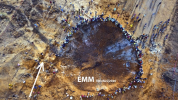
In the above picture it looks like the road is to the right, and that the object came from the left. I don't know exactly what the white arrow means, but it would be close to the touch down point, if the object came at an angle. One could also argue that the position of the crater while it overlaps the road does not match with the idea of a truck on the road exploding. It was something else.
There are a few videos of the occasion and below are some screen shots to give an impression. If you try to locate the large piece of asphalt that has fallen down into the crater, then you will be able to track it in other photos. In fact you can also see it in the photo from the air, where it is inside the crater, but close to where the road side would have been.
The first video from where screen dumps were taken was from:
Akure Explosion: I saw the Explosive laden Truck minutes before it exploded- Witness
In the first picture you have the pieces of asphalt to the left.

In the next the pieces of asphalt are on the opposite side of the photographer
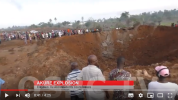
The second video is:
Early Morning Blast Rocks Area Near Akure Owo Highway
Next the asphalt is just below where the people are standing. One can see more people walking on the road.

Below the asphalt pieces are to the left.

See also Blast in Akure: Governor Akeredolu visits scene - P.M. News has:
 www.pmnewsnigeria.com
www.pmnewsnigeria.com
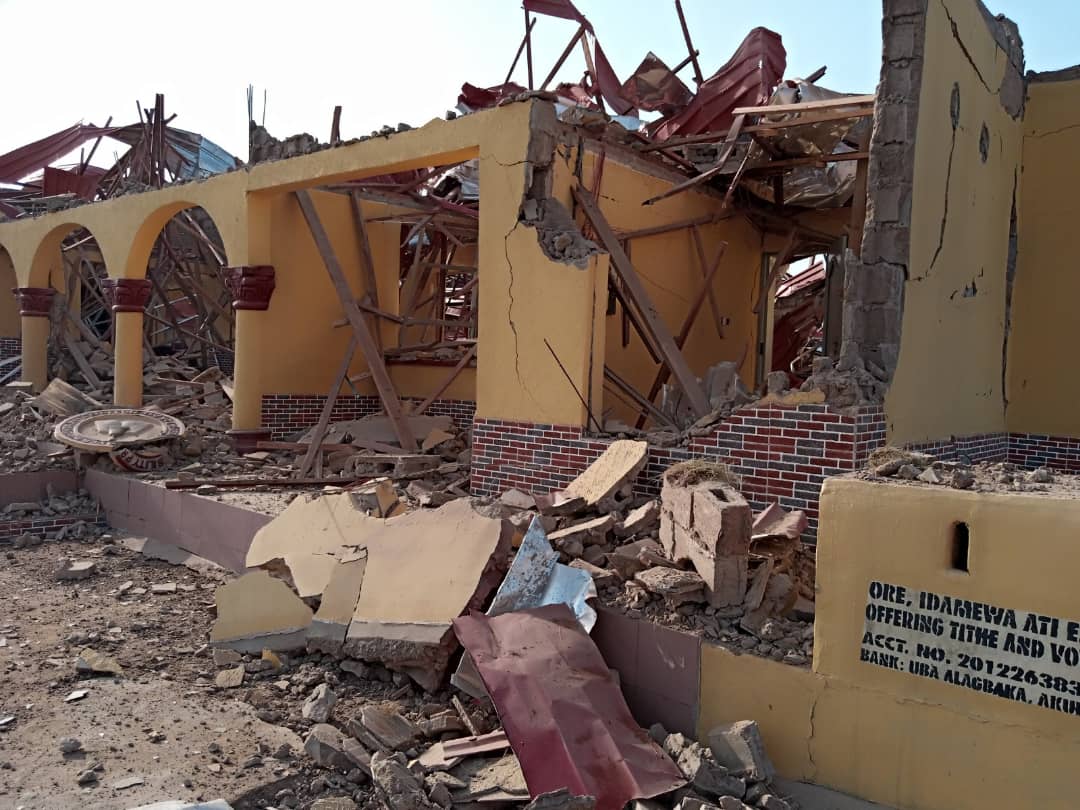
 tribuneonlineng.com
tribuneonlineng.com

 tribuneonlineng.com
tribuneonlineng.com
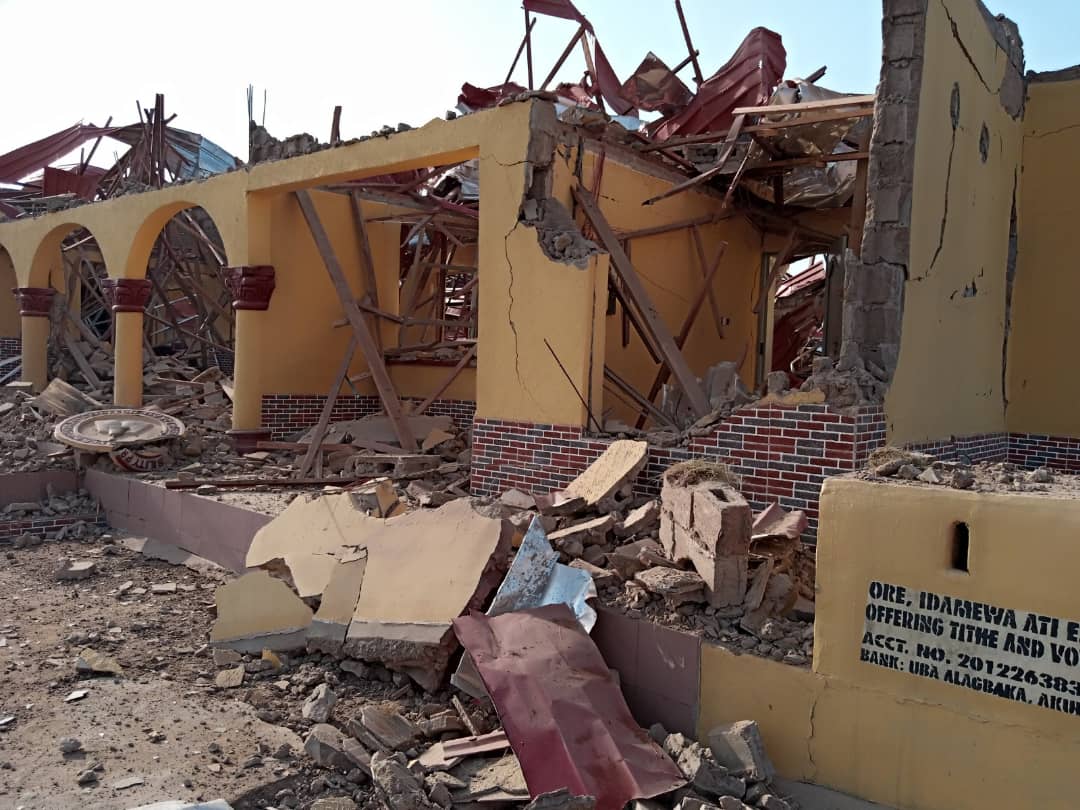
 tribuneonlineng.com
Maybe it is worth keeping an eye on this story and see what kind of official explanation they will end up with. It wouldn't take a couple of excavators and trucks too long to fill the hole, but they don't do that. The re-route the road and investigate what happened.
tribuneonlineng.com
Maybe it is worth keeping an eye on this story and see what kind of official explanation they will end up with. It wouldn't take a couple of excavators and trucks too long to fill the hole, but they don't do that. The re-route the road and investigate what happened.
Edit: A picture of the location:
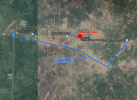

Ondo State is the largest producer of Cocoa in Nigeria according to the local state home page. Ondo state produces also oil, and has bitumen and tar sand.
Here are the mentions already:
Below is a photo taken from above used at the website of one of the popular forums in Nigeria Akure ‘explosion’ Was Impact From Meteors NOT Explosives, Says OAU Prof - Politics - Nigeria but they used much of the content from Akure 'explosion' was impact from meteors NOT explosives, says OAU prof - TheCableCoronavirus epidemic in China: Apocalypse Now! Or exaggerated scare story?
You made a very good observation, Adobe. Laura posted this article a while ago on FB: https://www.thecable.ng/.XoF21GBdR_c.facebook So that is fairly wicked. What's in store coming our way? I sometimes think the C's are very cynical with their 'Wait and see!' quip. In combination with Laura's...
anka
Session 21 March 2020
you were pretty close in your evaluation Don Cesar, Home - TheCableakure-explosion-was-impact-from-meteors-not-explosives-says-oau-prof The experts led by Adepelumi Adekunle, a professor of geophysics and earthquake engineering at Obafemi Awolowo University, said the meteors impacted...
Laurentien2
Coronavirus epidemic in China: Apocalypse Now! Or exaggerated scare story?
In reference to the asteroid/explosion in Akure: The roof seems like it was blasted from above, and the side or ground level walls, have no sigh of dirt or rocks having blasted them? Explosion from above first?
Adobe
Coronavirus epidemic in China: Apocalypse Now! Or exaggerated scare story?
Hm - around Akure - many houses have damaged roofs Breaking: Akure Asteroid! I Speak With My Mum And Sister Who Are In Ekiti "very loud noise, a hose was shaking" an interview with witness
Blacki
Coronavirus epidemic in China: Apocalypse Now! Or exaggerated scare story?
Not available, they are censoring or what, still can't access any video.
Laurentien2
Coronavirus epidemic in China: Apocalypse Now! Or exaggerated scare story?
Removed already!
stellar
Coronavirus epidemic in China: Apocalypse Now! Or exaggerated scare story?
Here's the TV news report of the asteroid/explosion in Akure, the Ondo State capital.
Jones
Session 21 March 2020
Does not look like that crater could be caused by explosives on a truck.
Laura
Session 21 March 2020
It really look like a cover up, here are some comment on this article; Confusion as 'loud blast' hits Akure on Saturdayakure/ Veer veer • a day ago It is not an explosion! NASA warned about asteroid earlier... They stated that a fragment of it can end civilization when it hits the...
Laurentien2
Coronavirus epidemic in China: Apocalypse Now! Or exaggerated scare story?
Now there is this I snagged from the session thread:
Laura
Session 21 March 2020
Folks on social media are arguing that this may be a bomb blast, while others are convinced that this was an asteroid. Breaking: What really caused Akure explosion. — Daily Times Nigeriaakure-explosion/
Laurentien2
Session 21 March 2020
Very strange, from what I could see there are no debris of truck being buried in the crater, UPDATED: Vehicle carrying explosives caused Akure blast – Akeredoluakure-explosion-akeredolu/
Laurentien2
Session 21 March 2020
...by a terrorist attack with a vehicle-borne improvised explosive device (VBIED) or even a small asteroid impact. https://southfront.org/nigeria-massive-explosion-splits-akure-owo-road-damage-dozens-of-houses-videos/ Can't watch the video, probably to much traffic this morning, what do you...
Laurentien2
SOTT monthly Earth Changes Summary video suggestions
28 March, possible meteorite impact in Nigeria ...authorities say that it was a truck with explosives but...
mabar
The Researchgate page of the Nigerian Professor is https://www.researchgate.net/profile/Adekunle_Adepelumi2The explosion that rocked Akure, Ondo state capital, on Saturday, was caused by a giant rock from space known as meteors, a team of experts have concluded.
A meteor is what happens when a meteoroid – a small piece of an asteroid – burns up upon entering earth’s atmosphere, creating a streak of light in the sky.
The experts led by Adepelumi Adekunle, a professor of geophysics and earthquake engineering at Obafemi Awolowo University, said the meteors impacted the location from “an angle of 43 degrees”.
TheCable obtained a copy of their report findings on the explosion on Sunday.
[..]
Rotimi Akeredolu, governor of the state, had told journalists the blast occurred after a truck conveying explosives to a quarry exploded.
“I have been briefed by the security chiefs that in the early hours of Saturday March 28th, a vehicle in a convoy transporting explosives to a storage facility in a neighbouring state developed a fault while in transit along the Akure Owo Road about 2km from the Akure Airport,” the governor had said.
But Adekunle said findings by his team suggest the explosion was caused by a natural phenomena, thereby contradicting the governor.
He added there was no evidence of a buried vehicle, buried ordinance or explosives from the site, and that “foreign rocks and strange metallic objects” were found within the crater crated.
His report read: “My Research group carried out a detailed analysis of the impact site. A circular impact crater with 21m diameter and 7.8m depth was found which suggest a natural phenomenal.
“Water was found oozing out from the edges of the crater. A preliminary insitu vibration, noise, seismicity, water analysis, radioactivity studies, rock and soil investigation were carried out.
“Our findings suggest that the impact of the blasting covers 1km radius of the surroundings of the crater. No evidence of fire or Burning of anything was found within the vicinity.
“No evidence of radioactivity radiation was found within the crater and immediate vicinity. The field evidence point to a conclusion that a meteoric from an asteroid belt that travels at a great speed from space impacted the location at an angle of 43 degrees created an ejecta at South-Western part.”
He also said a crack opening that vary in thickness from 3mm to 4 metres occurred on the wall of most of the buildings in the area, “but not at the base of the buildings”.
[...]
This kind of explosions happen elsewhere — and not the first that Nigeria has suffered.
In 1962, a farmer was almost struck by a big meteorite when it came crashing down in Zagami, Katsina state.
See also the page of the University: https://oauife.academia.edu/adepelumiadekunle and he has done previous work on impact structures in
Here is the photo taken from above the crater in Akure:An appraisal of the Serra da Cangalha impact structure using the Euler deconvolution method
by Sergio Fontes, Jean M Flexor, and adepelumi adekunle
Meteoritics & Planetary Science, 2005

In the above picture it looks like the road is to the right, and that the object came from the left. I don't know exactly what the white arrow means, but it would be close to the touch down point, if the object came at an angle. One could also argue that the position of the crater while it overlaps the road does not match with the idea of a truck on the road exploding. It was something else.
There are a few videos of the occasion and below are some screen shots to give an impression. If you try to locate the large piece of asphalt that has fallen down into the crater, then you will be able to track it in other photos. In fact you can also see it in the photo from the air, where it is inside the crater, but close to where the road side would have been.
The first video from where screen dumps were taken was from:
Akure Explosion: I saw the Explosive laden Truck minutes before it exploded- Witness
In the first picture you have the pieces of asphalt to the left.

In the next the pieces of asphalt are on the opposite side of the photographer

The second video is:
Early Morning Blast Rocks Area Near Akure Owo Highway
Next the asphalt is just below where the people are standing. One can see more people walking on the road.

Below the asphalt pieces are to the left.

See also Blast in Akure: Governor Akeredolu visits scene - P.M. News has:
The blast, which occurred on Akure-Owo Road, was suspected to be from a meteorite. But Governor Akeredolu said it came from a vehicle carrying explosives to a nearby state.
The explosion left a crater. Akeredolu explained that the crater was caused by the exploded vehicle, which sank.
[...]
Nigerian Tribune said the explosion caused some injuries and blew off the roof of a church nearby.
The newspaper said the explosion happened at Eleyowo village, less than a kilometre to Akure Airport. It said the impact destroyed a church and a school in the area.
Akure blast: Police IG Adamu sets up probe team - P.M. News
Inspector General of Police, Mohammed Adamu, sets up a probe team to unravel the cause of the explosion that occurred at Ogbese near Akure
 www.pmnewsnigeria.com
www.pmnewsnigeria.com
The team led by Professor Adekunle Abraham Adepelumi said:
“The field evidence point to a conclusion that a meteoric from an asteroid belt that travels at a great speed from space impacted the location at an angle of 43 degrees created an ejecta at South-Western part. No evidence of buried vehicle, buried ordinance or IED was found”,

PDP demands forensic investigation of Akure explosion
PDP has called on Federal Government to immediately set up an inter-agency panel of inquiry to investigate the explosion that rocked Akure...

Akure explosion: Our thoughts, prayers with victims ― APC
The APC National Working Committee has sympathised with victims of the Saturday explosion in Ilu-Abo, along the Akure-Owo, Ondo State........

UPDATE: More photos of the explosion that rocked Akure, Ondo State, this morning
More photographs have emerged of the destruction that took place this morning during the explosion that happened in Akure, the Ondo State capital. More
Edit: A picture of the location:

Last edited:
Yes this is a good example of how networking work, how the feild of information can be accessed by so many today that it kind of become a double edged sword for the ptb. Information are entering so fast that they can't stop it or censore it fast enought, truth can't be buried. It prove that they don't have total control yet but I'm afraid that they may try to stop that flow of information soon, that it is just a question of time before cuting our access to this information feild.
Let wait and see.
Let wait and see.
This is less academic but a Tweet had this picture below, modified from a different source, and while it may be figuratively related to the impact of the Coronavirus, this does not have to be the only interpretation. In the past the explanation for many hidden international political dealings was "It's the economy stupid", but in the picture we have the Cosmos responding and now the expression changes to something else:Let wait and see.

On Sott, it is sometimes reported which color the fireball or meteor had. Below are a couple of excerpts that may help explaining the observations of different colours. I became interested in the details because someone asked in a comment to an article.
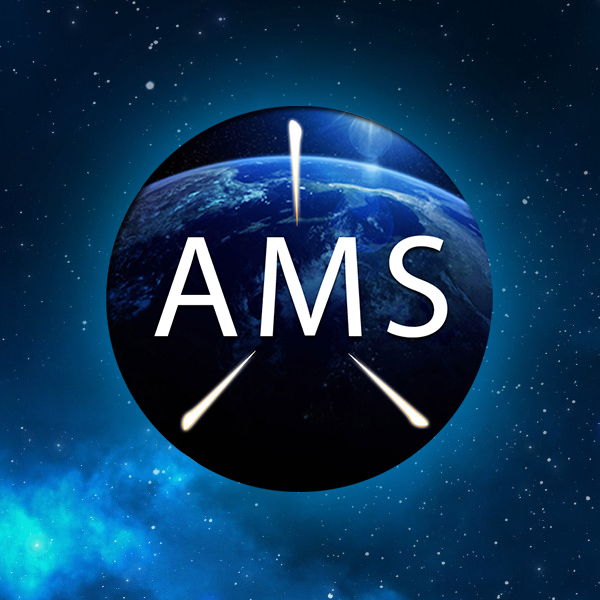
 www.amsmeteors.org
www.amsmeteors.org
Finally, while the light and size of meteors and fireballs may be interesting, if the day comes and you see a very bright meteor, take care of your eyes. And if it is super large fireball and close, it is better not to look at it from behind a window glass, because if there is a sonic boom, as there was in Chelyabinsk in 2013, and the window splinters then it can lead to damage.

Fireball FAQs
The American Meteor Society, Ltd. is established to inform, encourage, and support the research activities of people who are interested in the field of Meteor Astronomy
5. Can fireballs appear in different colors?
A similar story from an explanation of the Leonid meteor stream on a webpage from NASA:Vivid colors are more often reported by fireball observers because the brightness is great enough to fall well within the range of human color vision. These must be treated with some caution, however, because of well-known effects associated with the persistence of vision. Reported colors range across the spectrum, from red to bright blue, and (rarely) violet. The dominant composition of a meteoroid can play an important part in the observed colors of a fireball, with certain elements displaying signature colors when vaporized. For example, sodium produces a bright yellow color, nickel shows as green, and magnesium as blue-white. The velocity of the meteor also plays an important role, since a higher level of kinetic energy will intensify certain colors compared to others. Among fainter objects, it seems to be reported that slow meteors are red or orange, while fast meteors frequently have a blue color, but for fireballs the situation seems more complex than that, but perhaps only because of the curiosities of color vision as mentioned above.
The difficulties of specifying meteor color arise because meteor light is dominated by an emission, rather than a continuous, spectrum. The majority of light from a fireball radiates from a compact cloud of material immediately surrounding the meteoroid or closely trailing it. 95% of this cloud consists of atoms from the surrounding atmosphere; the balance consists of atoms of vaporized elements from the meteoroid itself. These excited particles will emit light at wavelengths characteristic for each element. The most common emission lines observed in the visual portion of the spectrum from ablated material in the fireball head originate from iron (Fe), magnesium (Mg), and sodium (Na). Silicon (Si) may be under-represented due to incomplete dissociation of SiO2 molecules. Manganese (Mn), Chromium (Cr), Copper (Cu) have been observed in fireball spectra, along with rarer elements. The refractory elements Aluminum (Al), Calcium (Ca), and Titanium (Ti) tend to be incompletely vaporized and thus also under-represented in fireball spectra.
Leonid MAC - Facts on meteors and meteor showers
Background facts on meteors and meteor showers
leonid.arc.nasa.gov
METEORS: Meteors are better known as "shooting stars": startling streaks of light that suddenly appear in the sky when a dust particle from outer space evaporates high in the Earth's atmosphere. We call the light phenomenon in the atmosphere a "meteor", while the dust particle is called a "meteoroid".
- Size: Most visible Leonids are between 1 mm and 1 cm in diameter. For example, a Leonid meteor of magnitude +5, which is barely visible with the naked eye in a dark sky, is caused by a meteoroid of 0.5 mm in diameter and weights only 0.00006 gram.
- Speed That tiny particle can cause a light so bright that it can be seen over distances of hundreds of kilometers. The reason is the astronomical speed of the meteoroids. Just before they enter the Earth's atmosphere, Leonid meteoroids travel at 71 kilometers per second, or some 2,663 times as fast as a fast pitch in baseball, or, if you want, around the Earth in 3.8 minutes!
- Source of light When meteoroids enter the Earth's atmosphere, they collide with numerous air molecules. Those collisions sputter away the outer layers of the particle, creating a vapor of sodium, iron and magnesium atoms. In subsequent collisions, electrons are knocked into orbits at larger mean distances from the nucleus of the atoms. When the electrons fall back to their rest positions, light is emitted. This is the same process as in gas discharge lamps.
- Colors of meteors The color of many Leonids is caused by light emitted from metal atoms from the meteoroid (blue, green, and yellow) and light emitted by atoms and molecules of the air (red). The metal atoms emit light much like in our sodium discharge lamps: sodium (Na) atoms give an orange-yellow light, iron (Fe) atoms a yellow light, magnesium (Mg) a blue-green light, ionized calcium (Ca+) atoms may add a violet hue, while molecules of atmospheric nitrogen (N2) and oxygen atoms (O) give a red light. The meteor color depends on whether the metal atom emissions or the air plasma emissions dominate.
- Sounds Meteors do not normally cause audible sounds. Hence, they will pass by unnoticed if not seen. But watch out for hissing sounds that have been reported for very bright meteors. These sounds are thought to be due to very low frequency (VLF) radio waves interacting with the local environment. A sonic boom is sometimes heard for very bright Leonid meteors, called fireballs, that appear near your own observing site high in the sky. If the particle is larger than the mean free path of the air molecules, a high Mach number shock wave forms in front of the meteoroid. Very rarely, this shock wave penetrates deep enough in the atmosphere that it can be heard. It sounds like the sonic boom of an airplane, but as a distant rumble.
Figure 2: The left image shows a bright afterglow in the path of a meteor while the meteor itself is seen to move onward. Video frame from the 04:00:29 UT fireball by Peter Jenniskens. The right image shows a persistent train high in the sky above an observatory dome minutes after the meteor itself has faded. The train enables telescopes to point at the path of a meteor. This train was photographed by the Uma team of the Observatori Astronomic de Mallorca, Spain.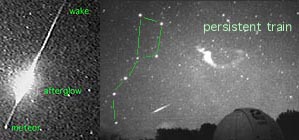
PERSISTENT EMISSIONS: Bright meteors leave persistent glows.
- Wake is the brief glow behind the meteor head. The wake is caused mainly by the green light of neutral oxygen atoms. Wakes last 1-10 seconds. Sometimes the term wake is also used to describe the area directly behind the meteor head.
- Afterglow is the persistent metalic atom (Na, Fe,Mg) emission glow in the path of bright fireballs. The afterglow lasts a few seconds.
- Persistent train is the long enduring emission that remains in the path of a bright fireball once the afterglow has faded. Persistent trains can last for 1-30 minutes (typically 4-6 minutes) at an apparent brightness of +4 to +5 magnitude. The optical light of these long enduring trains is from Na (sodium) and FeO (iron oxyde), from airglow-type chemistry of the recombination of oxygen atoms and ozone molecules that is catalised by sodium and iron atoms. Persistent trains last long enough to enable telescopic studies of the path of a meteor. Upper atmosphere winds distort the shape of the train.
This should mean that when one watches a camera recording of a meteor passing in the night sky, and say the trail in one frame is 3 cm. Then the traditional way was to compare the brightest part with the visual magnitude of a known star, but the author is saying that this is inaccurate, because while the meteor was busy moving and leaving light in its trail for the duration of the frame, the star shone its light in just one area of the picture. To correct the error they have a method involving mathematics. The result is that the visual magnitude of meteors is larger using the new method, than can be determined from a picture using the old method.The traditional method of the meteor brightness measurements claims that the meteor brightness is equal to the stellar magnitude of a star that looks like a meteor in the brightest point of its track. [...]This traditional method suffers from systematic errors, particularly those that arise from using stellar brightness measured in specific spectral wave bands different from the observer's ones, but mainly due to neglecting the influence of the meteor angular velocity on the real meteor brightness. [...]
Finally, while the light and size of meteors and fireballs may be interesting, if the day comes and you see a very bright meteor, take care of your eyes. And if it is super large fireball and close, it is better not to look at it from behind a window glass, because if there is a sonic boom, as there was in Chelyabinsk in 2013, and the window splinters then it can lead to damage.
SOTTREADER
The Living Force
Put on a colour show
SOTTREADER
The Living Force
This happened 9 April - anyone know anything about it? 
Apparently it happened in NYC... Any more info?

Apparently it happened in NYC... Any more info?
SOTTREADER
The Living Force
Found more information of it... Apparently just a storm! I thought it was an overhead explosion and the shockwave took down the trees!!
It wasn't in NYC either.
It wasn't in NYC either.
SOTTREADER
The Living Force
Ha! What is this?
Apparently something fell from the sky into that lake and left that strange fire looking thing... The people filming are clearly confused.
Happened yesterday.
Apparently something fell from the sky into that lake and left that strange fire looking thing... The people filming are clearly confused.
Happened yesterday.
Ha! What is this?
Apparently something fell from the sky into that lake and left that strange fire looking thing... The people filming are clearly confused.
Happened yesterday.
I had to go to the video to learn that it was in the Bahamas. (Helps to include whatever details you can find.)

